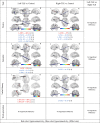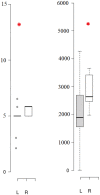Dynamic causal modeling of reorganization of memory and language networks in temporal lobe epilepsy
- PMID: 37776067
- PMCID: PMC10723230
- DOI: 10.1002/acn3.51908
Dynamic causal modeling of reorganization of memory and language networks in temporal lobe epilepsy
Abstract
Objective: To evaluate the alterations of language and memory functions using dynamic causal modeling, in order to identify the epileptogenic hemisphere in temporal lobe epilepsy (TLE).
Methods: Twenty-two patients with left TLE and 13 patients with right TLE underwent functional magnetic resonance imaging (fMRI) during four memory and four language mapping tasks. Dynamic causal modeling (DCM) was employed on fMRI data to examine effective directional connectivity in memory and language networks and the alterations in people with TLE compared to healthy individuals.
Results: DCM analysis suggested that TLE can influence the memory network more widely compared to the language network. For memory mapping, it demonstrated overall hyperconnectivity from the left hemisphere to the other cranial regions in the picture encoding, and from the right hemisphere to the other cranial regions in the word encoding tasks. On the contrary, overall hypoconnectivity was seen from the brain hemisphere contralateral to the seizure onset in the retrieval tasks. DCM analysis further manifested hypoconnectivity between the brain's hemispheres in the language network in patients with TLE compared to controls. The CANTAB® neuropsychological test revealed a negative correlation for the left TLE and a positive correlation for the right TLE cohorts for the connections extracted by DCM that were significantly different between the left and right TLE cohorts.
Interpretation: In this study, dynamic causal modeling evidenced the reorganization of language and memory networks in TLE that can be used for a better understanding of the effects of TLE on the brain's cognitive functions.
© 2023 The Authors. Annals of Clinical and Translational Neurology published by Wiley Periodicals LLC on behalf of American Neurological Association.
Conflict of interest statement
There is no conflict of interest for any of the authors to disclose.
Figures









References
-
- Wiebe S, Blume WT, Girvin JP, Eliasziw M. A randomized, controlled trial of surgery for temporal‐lobe epilepsy. N Engl J Med. 2001;345:311‐318. - PubMed
-
- Berg AT, Scheffer IE. New concepts in classification of the epilepsies: entering the 21st century. Epilepsia. 2011;52:1058‐1062. - PubMed
-
- Metternich B, Buschmann F, Wagner K, Schulze‐Bonhage A, Kriston L. Verbal fluency in focal epilepsy: a systematic review and meta‐analysis. Neuropsychol Rev. 2014;24:200‐218. - PubMed
Publication types
MeSH terms
Grants and funding
LinkOut - more resources
Full Text Sources

